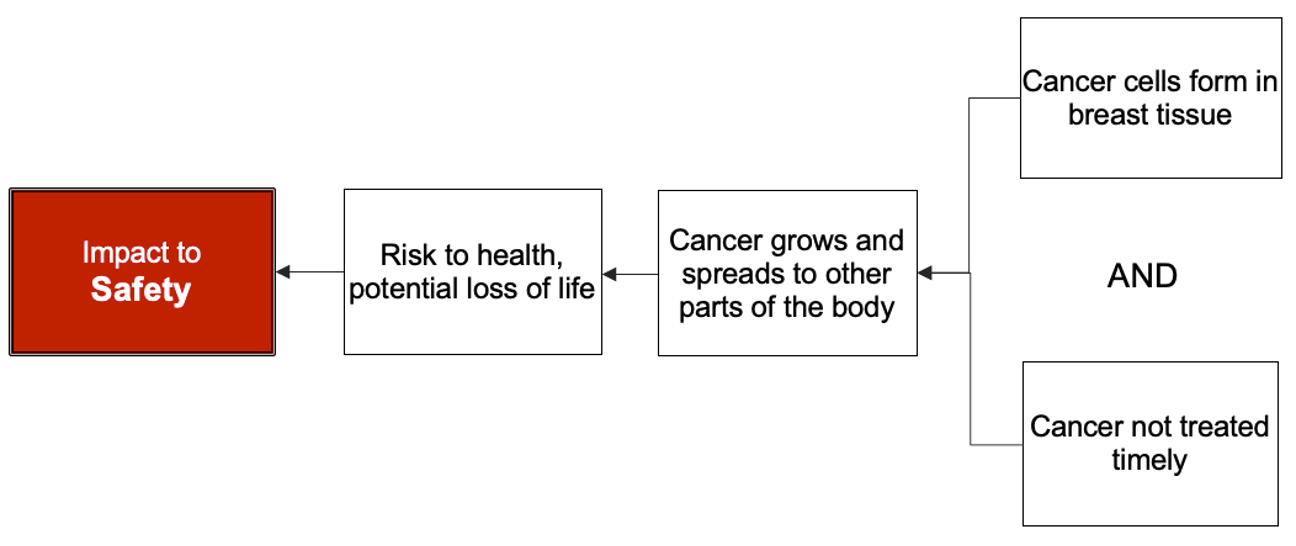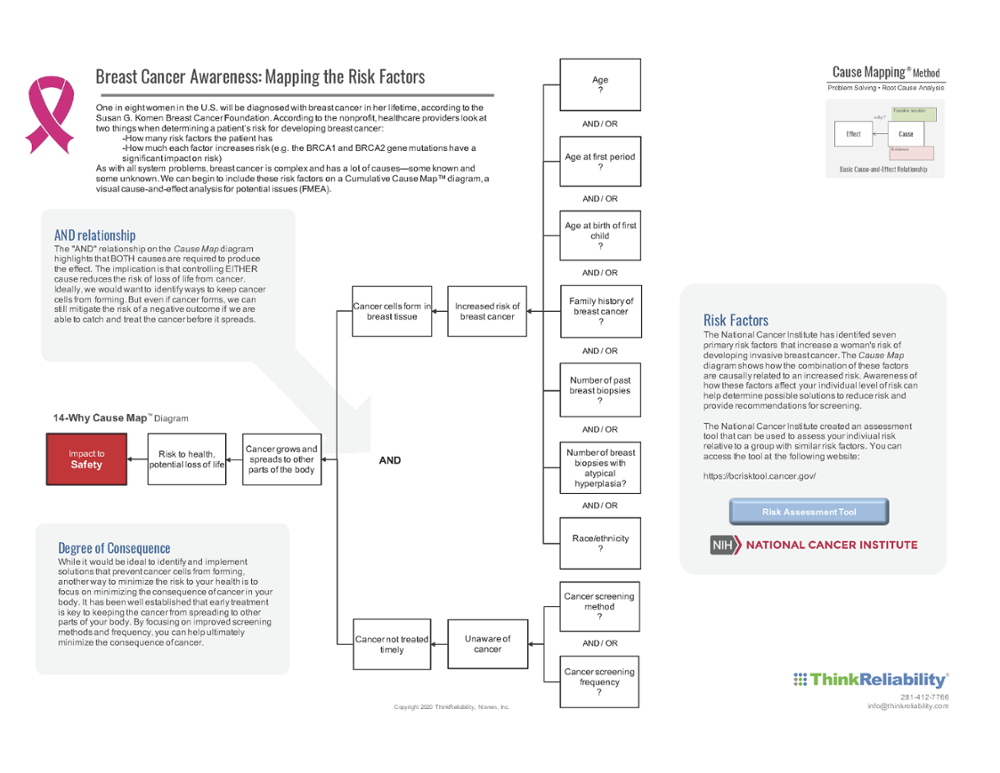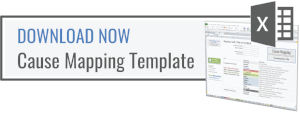One in eight women in the U.S. will be diagnosed with breast cancer in her lifetime, according to the Susan G. Komen Breast Cancer Foundation. According to the nonprofit, healthcare providers look at two things when determining a patient’s risk for developing breast cancer:
- How many risk factors the patient has
- How much each factor increases risk (e.g. the BRCA1 and BRCA2 gene mutations have a significant impact on risk)
As with all system problems, breast cancer is complex and has a lot of causes—some known and some unknown. Men are less likely than women to develop breast cancer, though it does occur. For women, primary risk factors include:
- age
- age at first period
- age at the time of the birth of her first child (or not having given birth)
- family history
- number of breast biopsies
- number of breast biopsies showing atypical hyperplasia
- race/ethnicity
If we put these risk factors on a cumulative Cause Map™ diagram, a visual cause-and-effect analysis for potential issues (FMEA), we start with our goal of safety because breast cancer presents a risk to health and a potential loss of life. From there, we can read the Map from left to right by asking Why questions. “Why was there a risk to health, potential loss of life?” Because “Cancer grows and spreads to other parts of the body.” We can continue reading it this way as we move toward the right.

But if we look to the Cause Map diagram, we see that cancer grows and spreads to other parts of the body because the cancer cells form in the breast tissue AND the cancer is not discovered and treated quickly. The first causal path shows those risk factors that, for the most part, cannot be controlled. You’ll notice there are question marks on each of those causes. A question mark acts as an indication that additional information or evidence is required to prove or disprove the cause or the piece of information. So, in this case, the question marks indicate where a patient’s particular factors would be included.
By understanding it takes both of those causes (the cancer cells form in the breast tissue AND the cancer is not discovered and treated quickly) for the cancer to spread and present a risk, we see additional solution opportunities with the other causal path. The second path presents opportunities for finding and treating the cancer in a timelier manner. This is why we build a Cause Map diagram—the more causes that are uncovered, the more opportunities we have to create a cumulative reduction in risk.
While it would be ideal to identify and implement solutions that prevent cancer cells from forming, another way to minimize the risk to your health is to focus on minimizing the consequences of cancer in your body through things like improved screening methods and frequency of screenings. The earlier the cancer is caught, the more likely that treatment will be effective. While these strategies don’t reduce your risk of getting cancer, screening and routine self-exams may help catch it in an earlier stage.
Click on the image below to download the one-page PDF.
Keep in mind, we’re only showing a small part of an incredibly complex and all-too-often tragic disease. There are additional causes not shown here that may provide risk reduction opportunities. For example, the Mayo Clinic suggests limiting alcohol consumption and postmenopausal hormone therapy, while also maintaining a healthy weight with a healthy diet and exercise—but unfortunately, those don’t affect those seven primary risk factors we listed. Additionally, aggressive preventative measures exist for those at high risk, like preventative medications and surgeries. The Cause Map diagram can expand to include those additional causes and details as needed.
Interested in seeing your risk or a loved one’s estimated risk factor of developing breast cancer? The National Cancer Institute has developed a breast cancer risk assessment tool (the Gail Model) that calculates the patient’s estimated risk factor of developing breast cancer in the next five years and over her lifetime. Although it is by no means definitive, it’s a tool that allows you to see your level of risk based on existing data. Take the assessment here. There are additional assessment tools available, like IBIS, BOADICEA and the Claus model. But these are only tools. If you have questions about your breast cancer risk, please talk to your doctor about what breast cancer screening strategies and preventative measures are right for you. Remember, we are not medical professionals, just problem solvers.
Interested in learning more about Cause Mapping® root cause analysis? Consider signing up for one of our upcoming free webinars.












